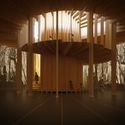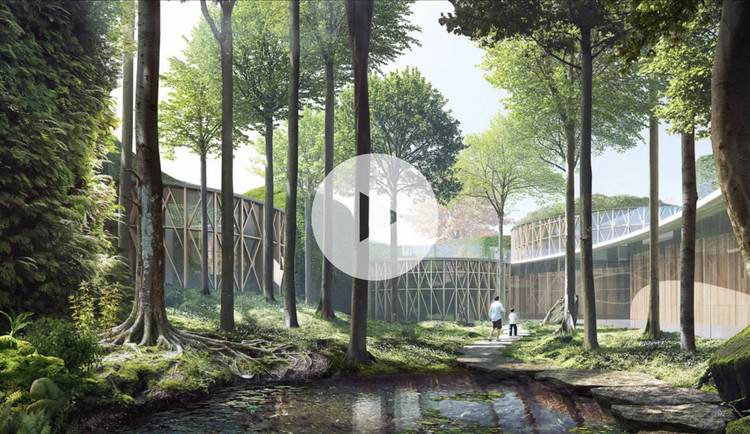To answer the Biennale's question of "How Will We Live Together", curators of the national pavilions explored what the future would look like in an architectural, cultural, and environmental context. Many saw the future as an entirely virtual environment whereas other highlighted the cruciality of physical coexistence with neighbors. ArchDaily met with Ippolito Pestellini Laparelli, curator of the Russian Pavilion, to discuss how the idea of the pavilion came together throughout the year as a virtual platform for interdisciplinary creative thinkers, the role of cultural institutions across physical and digital spaces, and how digitalization is always part of the conversation.
News
"Dissecting the Politics and Mechanics of Institutions": In Conversation with Russian Pavilion Curator Ippolito Pestellini Laparelli at the 2021 Venice Biennale
Past, Present and Future: Brick Architecture in Texas, Kansas, and Illinois

Today, architects and builders have a multiplicity of options when it comes to specifying their cladding materials, having to balance their design vision with the user's requirements. In addition to the aesthetics and character of the chosen product, it is always important to verify its durability, low maintenance and long-term sustainability. The brick, widely used throughout the world, is not only recyclable and highly resistant to threats such as fire, wind and moisture, but also presents great ease of use, low cost, and high versatility in terms of sizes, shapes, colors and textures.
Showcasing the flexibility of the material, Heartland Brick has selected six notable and award-winning brick projects located in Texas, Kansas, and Illinois, ranging from its most classical use in arches and columns to its most modern and minimalist application, including an impressive mural of sculpted bricks. A lasting legacy for its designers and citizens, and an ongoing inspiration for the contractors and architects of the future.
Herzog & de Meuron to Convert Former San Francisco Power Plant into Mixed-Use Project

Construction work began for Herzog & de Meuron’s transformation of a former power plant building in San Fransico into a mixed-use project. Designed in collaboration with California-based practice Adamson Associates, the adaptive reuse of iconic Station A is part of the Portrero Power Station project, the redevelopment of a 29-acre industrial site into an extension of the Dogpatch neighbourhood. Herzog & de Meuron’s design retains and repurposes various features of the industrial building while adding a lightweight, steel-framed structure on top, thus giving new life to one of San Francisco’s landmarks.
Modular Components in Industrial Architecture

Industrial architecture usually requires fast installation, low-maintenance components, and flexible spaces that can be used for different purposes. Therefore, modular solutions are very common in this type of construction, also adding a powerful visual language to the building.
5 National Pavilions at the 2021 Venice Biennale that Explore Sustainability and Climate Change

The 17th Venice Architecture Biennale is currently unfolding, revealing a wide range of answers to the question "How will we live together". With 60 national pavilions, numerous contributions of invited architects from all around the world and several collateral events, this year's edition restates the Biennale's role as a platform for inquiry, exploration, and disruptive thinking in architecture. Curator Hashim Sarkis' original statement called upon architects "to imagine spaces in which we can generously live together." Recent circumstances have made the question even more relevant, prompting a holistic re-evaluation of how the world as a collective can face changes and challenges of an unprecedented scale from the disrupting role of technology, to inequality, mass migration and climate change. The following national contributions reflect on "how will we live together" amidst climate change, exploring ideas for a more sustainable future.
OMA Will Build Out the First American Pompidou Center in Jersey City

Three years after OMA was selected by the Jersey City Redevelopment Agency (JCRA) to design a new museum in Journal Square, the city’s downtown hub, it was revealed this morning that the building would be home to none other than the Pompidou Center’s first North American satellite: The Centre Pompidou × Jersey City.
Fire and Architecture: How Fire Shapes the Design of Buildings

Fire is an important consideration in the design of buildings. From material assemblies, to room layouts, to egress, and fire suppression systems, fire is a powerful force shaping the spaces we inhabit. This video talks about some of those factors while the host, Stewart Hicks, builds a campfire at a cabin in Northern Michigan. Over the course of choosing logs, building, lighting, and enjoying the fire, he breaks down how the construction of buildings relates to principles of constructing a good campfire. He covers theories by Gottfried Sempter, the evolution of fire in the home, considerations in wood frame construction, Bernoulli’s Principle, fire suppression systems, and much more. Grab a seat, bring ingredients for making s’mores, and enjoy some fun fire facts.
The Restroom Pavilion at the 2021 Venice Biennale Displays how Restrooms are Political Battlegrounds

"When we enter the restroom, we are never alone. Instead, we are entangled in a network of bodies, infrastructures, ecosystems, cultural norms, and regulations". Although restrooms are often overlooked facilities that cater to the needs of individuals, they are, however, spaces where gender, religion, race, hygiene, health, and the economy are defined and expressed. For the 17th International Architecture Exhibition at La Biennale di Venezia, Matilde Cassani, Ignacio G. Galán, Iván L. Munuera, and Joel Sanders designed two pavilions that exhibit how restrooms are political architectures, serving as battlegrounds for the world's disputes.
Cobe Wins Competition for Gothenburg University Library with Book-Inspired Design

Cobe’s winning design for the new library of the University of Gothenburg proposes a light, clean volume, whose slightly curved facades are a nod to the pages of an open book. The Danish architecture studio translates the concept of knowledge as the heart of a library into the interior spatial configuration of the project, while the architectural image evokes the idea of a lighthouse. Featuring a transparent and open ground floor, the new repository of knowledge creates a strong connection with the surrounding park, becoming a mediator between the city and the university.
Participatory Architecture: Community Involvement in Project Development

When designing community spaces, the architectural concept can easily clash with the user's experience. Therefore, engaging the community and future users in the project development and design process is a way of adding different perspectives to the architect's vision towards a more intelligent architecture.
Architect Michel Rojkind on the Social Responsibility of Design

In a Design and the City episode - a podcast by reSITE on how to make cities more liveable – Mexican architect Michel Rojkind talks about running, coming from a musical background, and the responsibility of architects to create buildings that can “give something relevant” back to the community. The interview delves into Rojkind’s philosophy of making sure that architectural conversations are not insular, but instead conversations that take place within a multi-disciplinary context.
Is Apprenticeship the Way That Architectural Education Stays Relevant?

This article was originally published on Common Edge.
In this week's Common Edge piece, Duo Dickinson explores his personal journey from teaching to practice to teaching again, and the differences he perceived. Stating that "no one today believes that school can fully prepare students for what architecture will become in 10 years", the author explains how architectural education has been evolving and questions what could be the best ways to ensure that education remains relevant.
From Your Eyes to my Eyes: Winning Places Selected by Aldo Amoretti

A few weeks ago the photographer Aldo Amoretti launched an unusual call inviting his and ArchDaily's followers to share their favorite places so that he could later photograph them, in a sense of a collective perspective and with the objective of discovering places. Last week we showed the finalists and today Amoretti has already chosen the places that he will go to document, which will be published on ArchDaily in the coming weeks.
Ford Assembly Plant Renovation Tops Out in Pittsburgh

ZGF Architects, Wexford Science & Technology, and The University of Pittsburgh have revealed new details of the Ford Motor Assembly Plant adaptive reuse in Pittsburgh. Called The Assembly, the project aspires to become a hub of university research, entrepreneurial activity, and innovation programming. The six-story crane shed was used to hoist parts unloaded from the Pennsylvania Railroad tracks for assembly.
5 Ways that Custom Ceiling Features Can Enhance an Interior Space

The ceiling – commonly referred to as "the fifth wall," – has the potential to transform an interior space from average into extraordinary. When it comes to design, the ceiling is often forgotten, and there are many missed opportunities to create moments of visual interest and delight.
"Housing Is A Universal Natural Right": In Conversation with French Pavilion Curator Christophe Hutin at the 2021 Venice Architecture Biennale
After several postponements and numerous challenges, the 17th Venice Architecture Biennale is finally taking place, bringing into focus a diverse array of answers to the question “How will we live together”. The theme gained even more relevance in the context of the pandemic and this year’s edition restates the importance of the Biennale as a platform for inquiry and collective exploration. Archdaily had the opportunity to meet in Venice with the curator of the French Pavilion, architect Christophe Hutin to discuss the thinking behind “Communities at Work” and the immersive experience of the exhibition.
The Sport Center in Panticosa by Álvaro Siza: Images of Abandonment

It's hard to forget the impact of economic crises on architecture; however, artist Jorge Isla reminds us with his series of photographs capturing the iconic High Performance Sports Center in the Balneario de Panticosa in Spain designed by architect Álvaro Siza. Construction on the site began at the start of the 21st century, but, due to heavy snows and Spain's financial upheaval, was abandoned shortly after.
Roofing Systems for Bamboo Buildings

Roofings are perhaps the most fundamental architectural element of bamboo buildings (together with foundations). Well-designed and built roofs play a key role in protecting a bamboo structure whilst adding to the beauty and experience of the space. What qualifies as a well-designed bamboo roof?
There are a couple of key elements that need to be considered: 1) the overhangs of the roof to mitigate the weathering of bamboo poles from direct sun and rain, 2) the pitch of the roof for water flow, 3) the spacing of the rafters for rigidity, and finally, 4) the material used. In Bali, we have experimented with many different roofing materials and techniques. In this article, we share 5 of the most commonly used roofing systems for our bamboo buildings:
In Southern California, Outdoor Dining Changes the Hospitality Landscape

"The explosion of outdoor dining is both a survival tool for restaurants and a welcome cultural shift that may be here to stay", states Jessica Ritz, in her article originally published on Metropolis. In fact, the author explores hospitality trends that have emerged during the pandemic in California, mainly outdoor dining, and that are likely to last or be present for a long time.
Flexible Outdoor Dining Spaces with High-Quality Canopies for All Seasons

When it comes to dining, drinking, and entertaining, outdoor spaces have overtaken all other venues. In the wake of concerns about hygiene and social distancing over the past year, patio and rooftop areas have become a crucial part of the hospitality industry. Fortunately, there are many innovative ways to make patio spaces that are comfortable and outdoor-friendly, not just during the summer but in any season.
ShadeFX manufactures innovative and versatile retractable shade solutions. Fully customizable and at the heart of every project, the patented ‘Single Track’ systems provide unrestrictive coverage for some of the world’s premier commercial, residential, institutional, and municipal properties. Below are several examples of spaces that have been designed to create an optimal outdoor dining experience.


























































